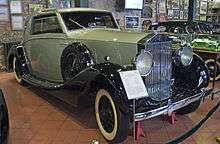Rolls-Royce Wraith (1938)
- This article is about the 1938 model of the Rolls-Royce Wraith. For the 2013 model, see Rolls-Royce Wraith (2013).
| Rolls-Royce Wraith | |
|---|---|
.jpg) | |
| Overview | |
| Manufacturer | Rolls-Royce Ltd |
| Production |
1938–39 (chassis) 491 produced |
| Body and chassis | |
| Related | Bentley Mark V |
| Powertrain | |
| Engine | 4257 cc Straight 6 |
| Transmission | 4 speed manual |
| Dimensions | |
| Wheelbase | 3.45 m (136 inches) |
| Length | 5.15 m (203 inches)[1] |
| Width | 1.87 m (74 inches)[1] |
| Kerb weight | 1.9 tons (approx) |
| Chronology | |
| Predecessor | 25/30 |
| Successor | Silver Wraith |
.jpg)

The Rolls-Royce Wraith was built by Rolls-Royce at their Derby factory from 1938 to 1939 and supplied to independent coachbuilders as a running chassis.
Wraith is also the name of a new coupé announced by Rolls-Royce in 2013.
Wraith is an old Scottish word meaning Ghost or Spirit.
Chassis design
The in-line six cylinder, overhead valve, 4,257 cc engine was based on that of the 25/30 but featured a cross-flow cylinder head. The four-speed gearbox had synchromesh on second, third and fourth speeds and retained the traditional right hand change.[1] The later engines were used as the basis for the Bentley MK V and the Corniche.
The Wraith featured an independent coil sprung front suspension based on a Packard 120 retaining semi elliptical leaf springs on the rear axle. The hydraulic dampers at the front had their damping rate controlled by governor and so varied with the speed of the car, making it superior to its predecessor, the 25/30 H.P. and on par with the Phantom III. The car was still built on a separate chassis but this was now of welded rather than the traditional riveted construction. The drum brakes were assisted by a mechanical servo driven by the engine patented by Hispano-Suiza and built by Rolls-Royce under licence. Wire wheels of 17 inch diameter were fitted, with the spokes usually covered by removable discs. A built in hydraulic jacking system was fitted operated by a lever under the passenger seat.
Performance
Cars based on the Wraith chassis could reach 85 mph (137 km/h); this was very dependent on the weight and style of body fitted. In one test by "The Motor" magazine in October 1938, a 0–50 mph time of 16.4 seconds was recorded.
Production
In 1938, a typical touring car cost £1700, which included the chassis cost of £1100. 492 chassis were made. Although chassis were only produced in 1939, cars bearing 1940 or later delivery and registration dates are not uncommon. Some cars were finished off during early 1940. Others were held in storage and sold and first registered during the war years. A few were actually bodied during wartime. In addition, 16 prewar chassis were bodied in early 1946 and duly delivered to the government. The final Wraith was delivered in 1947.
Film and book appearances
- Rolls-Royce Wraiths are featured in My Favorite Brunette (1947) and in a brief scene of Johnny Dangerously (1984).[2]
- The eponymous registration plate of the novel NOS4A2 belongs to a Rolls-Royce Wraith.
- A Rolls-Royce Wraith is also featured in The Man from U.N.C.L.E. episode 'The Foxes and Hounds Affair' (season 2, episode 4).
- The vampire Lara Raith temporarily provides wizard Harry Dresden with the use of a 1939 Rolls-Royce Wraith in Turn Coat.
See also
References
- 1 2 3 Bird, Anthony; Hallows, Ian; James, Brendan (2002). The Rolls Royce Motor Car: And the Bentley Since 1931 (6 ed.). Batsford Books. p. 432. ISBN 978-0-7134-8749-7.
- ↑ "Rolls-Royce Wraith in Movies and TV series", The Internet Movie Cars Database.
| Rolls-Royce Motor Cars timeline | |||||||||||||||||||||||||||||||
|---|---|---|---|---|---|---|---|---|---|---|---|---|---|---|---|---|---|---|---|---|---|---|---|---|---|---|---|---|---|---|---|
| Type | 1900s | 1910s | 1920s | 1930s | 1940s | 1950s | 1960s | 1970s | 1980s | 1990s | 2000s | 2010s | |||||||||||||||||||
| Ownership | Independent | Vickers plc | VW Group | BMW | |||||||||||||||||||||||||||
| Luxury car | 10 hp 15 hp |
V-8 20 hp |
Twenty | 20/25 | 25/30 | Wraith | WWII | Silver Dawn | Silver Cloud | Silver Shadow | Silver Spirit/Dawn | Silver Seraph | Ghost | ||||||||||||||||||
| Ultra-luxury car | 30 hp | 40/50 hp (Silver Ghost) | Phantom I/II/III | Silver Wraith | Silver Wraith II | Silver Spur | Ghost Extended Wheelbase | ||||||||||||||||||||||||
| Phantom IV | Phantom V/VI | Touring Limousine | Park Ward | Phantom | |||||||||||||||||||||||||||
| Convertible | Corniche/II/III/IV | Corniche V | Phantom Drophead | ||||||||||||||||||||||||||||
| Coupé | Camargue | Silver Spirit Hooper 2 Door | Phantom Coupé | ||||||||||||||||||||||||||||
| Wraith | |||||||||||||||||||||||||||||||